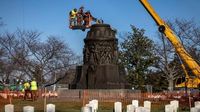Amid the quiet gravestones of Arlington National Cemetery, a monument once stood that sparked both reverence and controversy: the Confederate Reconciliation Monument. Removed in 2023 under congressional orders, the bronze statue is now set to return to its original location, igniting a fresh debate about how the United States remembers its Civil War past and the ongoing struggle over the symbols that define national identity.
Defense Secretary Pete Hegseth announced earlier this week that the monument, designed by Confederate veteran and sculptor Moses Ezekiel, will be restored and reinstalled at Arlington by 2027. The process, according to The Associated Press, will take about two years and cost taxpayers an estimated $10 million. The statue’s original base, damaged during its removal, must be replaced, and the entire piece will undergo meticulous refurbishment before it is returned to public view.
“It never should have been taken down by woke lemmings. Unlike the Left, we don’t believe in erasing American history — we honor it,” Hegseth wrote on X, formerly known as Twitter. His remarks echo a broader push by the Trump administration to restore what it calls a more “unifying and patriotic view” of the nation’s past. This move is directly tied to a 2025 executive order from President Donald Trump, which instructs federal agencies to review and potentially reinstate historical displays and monuments that were removed or altered in recent years. The order specifically discourages exhibits that, in the administration’s view, promote “divisive or ideologically driven narratives.”
The Reconciliation Monument’s journey from centerpiece to contested symbol — and now, its planned return — is emblematic of the wider national reckoning with Confederate imagery in public spaces. The statue was originally commissioned by the United Daughters of the Confederacy and unveiled in 1914, more than a decade after Congress approved the reburial of Confederate soldiers in Arlington’s Section 16. Ezekiel, a Confederate veteran himself, was buried at the base of the statue in 1921, alongside three other Confederate soldiers, cementing his legacy at the heart of the memorial.
The monument features a female figure representing the South, surrounded by 32 bronze figures that include soldiers, civilians, and mythological characters. Two of the most controversial depictions — an enslaved woman holding a white child and an enslaved man marching into battle — have drawn pointed criticism for what many see as a romanticized and deeply misleading portrayal of slavery. The inscription at the base of the statue echoes the so-called “Lost Cause” narrative, which frames the Confederacy’s defeat as noble and its cause as just, despite its defense of slavery.
Retired Army Brigadier General Ty Seidule, who served as vice chair of the congressional Naming Commission that recommended the monument’s removal, minced no words in his condemnation. “It’s the cruelest I’ve ever seen because it’s a pro-slavery, pro-segregation, anti-United States monument,” Seidule told The Washington Post. “It’s meant to say that the white South was right and the United States of America was wrong.” Seidule also emphasized that the decision to remove the statue was not about being “woke” but about confronting the painful truths of American history.
The monument’s initial removal in 2023 came at a cost of about $3 million, a process that involved carefully detaching the bronze sculpture and protecting the surrounding graves. According to a Pentagon official cited by The Associated Press, the monument was then transferred to a museum in Virginia for safekeeping. Its planned return, now backed by the Trump administration’s executive order, is part of a broader initiative to restore Confederate names and symbols that were discarded in the wake of the 2020 murder of George Floyd and the nationwide protests that followed.
Virginia Governor Glenn Youngkin voiced his support for the restoration, telling The Washington Post, “We are grateful for the care being taken to preserve and display this statue, which allows us to better understand the complex history of the United States.” Youngkin’s remarks reflect a viewpoint held by many supporters of the monument, who see it as an essential part of the cemetery’s broader history and a testament to national reconciliation after the Civil War.
Yet, the story of the Reconciliation Monument is not simply one of unity. Critics are quick to point out that the memorial was part of a national effort at reconciliation between North and South that too often came at the expense of racial equity. While Confederate soldiers were eventually honored at Arlington, efforts by Black Civil War veterans to move United States Colored Troops into the main cemetery were denied, and Arlington remained segregated until 1948. The memorial, therefore, stands as a complicated symbol — one that reflects both the desire for national healing and the realities of exclusion and inequality that persisted long after the war’s end.
Upon its return in 2027, visitors to Arlington will encounter not just the restored statue but also new panels offering historical context about its origins, symbolism, and the reasons for its placement within the cemetery. Pentagon officials have stated that this additional information is intended to help the public “better understand the complex history” surrounding the memorial. Whether this will be enough to address the concerns of critics remains to be seen.
For some, the restoration represents a dangerous step backward — a reassertion of symbols and narratives that many communities have worked hard to retire. For others, it’s a necessary act of preservation, a chance to confront history in all its complexity rather than erase uncomfortable chapters. The debate is far from settled, and as the monument’s return approaches, it will likely continue to serve as a flashpoint for conversations about memory, identity, and the meaning of reconciliation in modern America.
As the nation prepares for the statue’s reinstallation, the questions it raises about history, legacy, and the stories we choose to honor are sure to linger — not just among the rows of Arlington’s gravestones, but across the country as Americans grapple with the ever-evolving narrative of their shared past.
